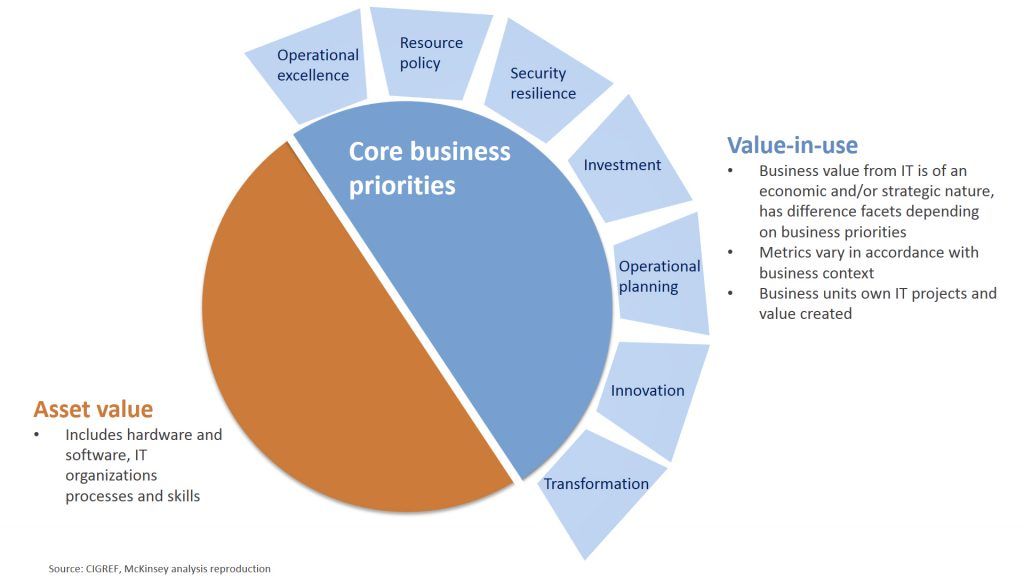In today’s digital era, CIOs must shift their priorities from cost cutting to driving revenue, and from process engineering to exploiting data if they want to achieve a set of broader business outcomes. Furthermore, understanding how to measure and communicate the business value of IT helps to foster a level of transparency that breaks down the barriers that traditionally exist between IT and the rest of the business.
Enterprise IT Value: A Total Snapshot
Enterprise IT creates value in two distinct ways, via:
- Asset Value: Acquisition of new technology is at the foundation of any business. This typically refers to hardware and software that keeps a business operational; and
- Business Value: Overall impact on business model and service delivery, these are enhancements to business priorities. Business value exists as a supplement to shareholder value to provide a greater picture of an organization’s true worth.

While asset value can be easily defined, business value is a little more abstract and therefore harder for enterprises to understand.
IT Business Value: A Major Shift in Thinking for CIOs
Business value has long been the cornerstone of the entire technology practice but has only recently gained mainstream attention thanks to the growing pace of digitalization. In fact, at least 84 percent of top CIOs surveyed in a recent Gartner study said they now have “responsibility for areas of the business outside of traditional IT, the most common being innovation and transformation.”
Overall, CIOs today must reinvest in new technologies and applications to drive more value. It’s no longer enough to just focus on cost-cutting initiatives. Not if they want to keep their jobs.
Other Key Determinants of the Business Value of IT
There are three other drivers of the business value of IT as discussed below:
IT and Productivity
This one seems like a given. There are number of ways to impact productivity using technology.
When tasks can be automated, people who would normally accomplish those tasks in their day-to-day can focus on other key functions. This should result in greater all around productivity.
Automation is one way technology works hand and hand with productivity, but another way includes on-demand services that affect the timeliness of key business decisions. Cloud services and big data environments can also be used to unleash productivity.
Moreover, the shift to DevOps increases service delivery.
IT and Forging Competitive Advantages
Running the business is essential, growing the business is commendable but transforming the business is critical. This is not to say that business value does not exist at the first two levels. However, the third one is where IT leadership should not only be forward-thinking in determining the ways in which the business can leverage new technology that puts them ahead of the competition but also up to the task of presenting key metrics as they build a case for new investments.
IT and Customer Satisfaction
The promise of faster service delivery, more automation and efficiency, integrated services with access anywhere — are attributes that will keep customers happy and loyal.
Using technology, businesses can even get intelligence that helps them time their product or service launches for the most client satisfaction or exposure. Making things easier for internal and external clients, also helps enterprises create business value through client satisfaction.
When to the Measure Business Value of IT
Measuring the business value of IT usually becomes important when discussing plans for new technology investments or determining budgets for ongoing support projects.
Though measuring business value is not something that can be done with a one-size-fits-all formula, the following tips can help you to understand where to begin when it comes to measuring the business value of your organization’s IT.
Understanding Key Definitions
When making funding requests, it’s important to understand some basic definitions about IT business value.
- Information Technology (IT): This refers to the entire department and not just hardware and software that is tangible and can be acquired. Funding IT means including the cost of transition, integration and services.
- Money and Funding: Think of money in terms of measurement units. While describing business value is complex and may require an effort that includes text in the language of a funding document, don’t leave it up to stakeholders to interpret what that translates to in dollar amounts. Come up with ways to calculate the dollar amount required based on business value assessed.
- Transactions and Services: Understand that these two things go hand-in-hand. A transaction is an exchange where something is delivered, and services are derived as a result. Both are required to measure the business value of IT.
- Business-as-Usual vs Change: A particularly difficult thing to understand is that some of the business value of IT is just making sure the regular functioning of the organization maintains. It’s a challenge for CIOs to put business value behind staying the same. Nonetheless, business value comes down to two groups: operating or change.
Whether you are putting together a funding proposal for a new project or an ongoing one, the above definitions in the context of business value should make presenting your case a lot more straightforward.
Now, let’s look at some of the ways to measure the business value of IT projects:
Assess Both the Strategic Value and Economic Value
Business value presents itself in two ways: strategic value and economic value. Economic value includes items that reduce cost or increase revenue. On the other hand, as the name suggests, strategic value deals in productivity enhancements, key differentiators that are included in your value proposition and customer satisfaction. Both are important considerations in measuring business value.
Optimize Investments by Lowering Operational Cost
Drawing a parallel between the amount spent on IT and decreases in operational spending is a good way to come up with thresholds for optimizing IT investments. In doing so, you’ll be able to make a strong case for business value.
Track Changes in Operations That Exceed KPIs
The business value of IT is largely visible in operations. Improvements to efficiency, cost reduction and more should result in the organization meeting and exceeding established key performance indicators (KPIs). This offers a well of data to draw from when making a case for the business value of IT.
Compare Average Industry Spend
Getting into financial and budgetary data when explaining the business value of IT to stakeholders can sometimes be a double-edged sword. IT spend can be pretty high for enterprises and oftentimes, comparing costs can bring to light other departments that receive less funding.
However, quantifying your enterprise IT spend against industry averages is generally an effective benchmark to use when making a case for business value. Most likely, if you’re investing in technology your competitors are too. With effective systems for mining data, this information can offer some explanation of business value with regard to average spend.
Should You Use ROI to Measure the Business Value of IT?
Some business unit heads in large organizations still want to hear metrics that they are familiar with such like the return on investment (ROI) of the project. Calculations for net present value (NPV) and internal rate of return (IRR) usually get thrown into the mix when you go down this path.
While ROI is a more clear-cut metric to use in assessing transformative technology projects, it’s much harder to quantify the outcomes of projects that keep the business going since these are never about top line growth. As Gartner outlines, “They are about reducing costs, cutting price-to-performance ratios and lessening risk.”
Overall, IT leaders need to offer at least one compelling value statement that demonstrates a thorough understanding of business key business outcomes. This will make a significant difference in the technology organization being viewed as a strategic partner instead of just a cost center.
Final Thoughts on the Business Value of IT
Making a case for business value of IT is challenging for even the most savvy CIO, but it’s an important concept to understand if your enterprise is going to keep moving forward with new technology and IT funding within the organization.
The ability to measure business value gives IT leverage to be a well-funded, fully operational department. In a climate where the bottom line is often the driving factor in business decisions, showing the big picture of what IT can accomplish in an organization is essential for establishing value with all key stakeholders.
E-book: Choosing the Right Metrics for Enterprise IT
Every business and organization can take advantage of vast volumes and variety of data to make well informed strategic decisions — that’s where metrics come in. This e-book introduces metrics in enterprise IT. Organizations of all shapes and sizes can use any number of metrics. In this e-book, we’ll look at four areas where metrics are vital to enterprise IT.
These postings are my own and do not necessarily represent BMC's position, strategies, or opinion.
See an error or have a suggestion? Please let us know by emailing blogs@bmc.com.







